Leadership Theories: Authentic and Transformational Leadership
VerifiedAdded on 2023/01/12
|8
|2276
|56
Essay
AI Summary
This essay provides a comprehensive overview of authentic and transformational leadership theories. It begins by defining authentic leadership, highlighting its key components such as self-awareness, relational transparency, balanced processing, and internalized moral perspective, and discusses their application within organizations. The essay then explores the role of both authentic and transformational leadership styles, emphasizing their impact on employee motivation, organizational change, and performance. The paper uses the example of Richard Branson's leadership to illustrate the practical application of these leadership styles, demonstrating how he integrates both approaches to foster innovation and employee engagement within Virgin Group. The essay concludes by summarizing the importance of effective leadership in achieving organizational goals.
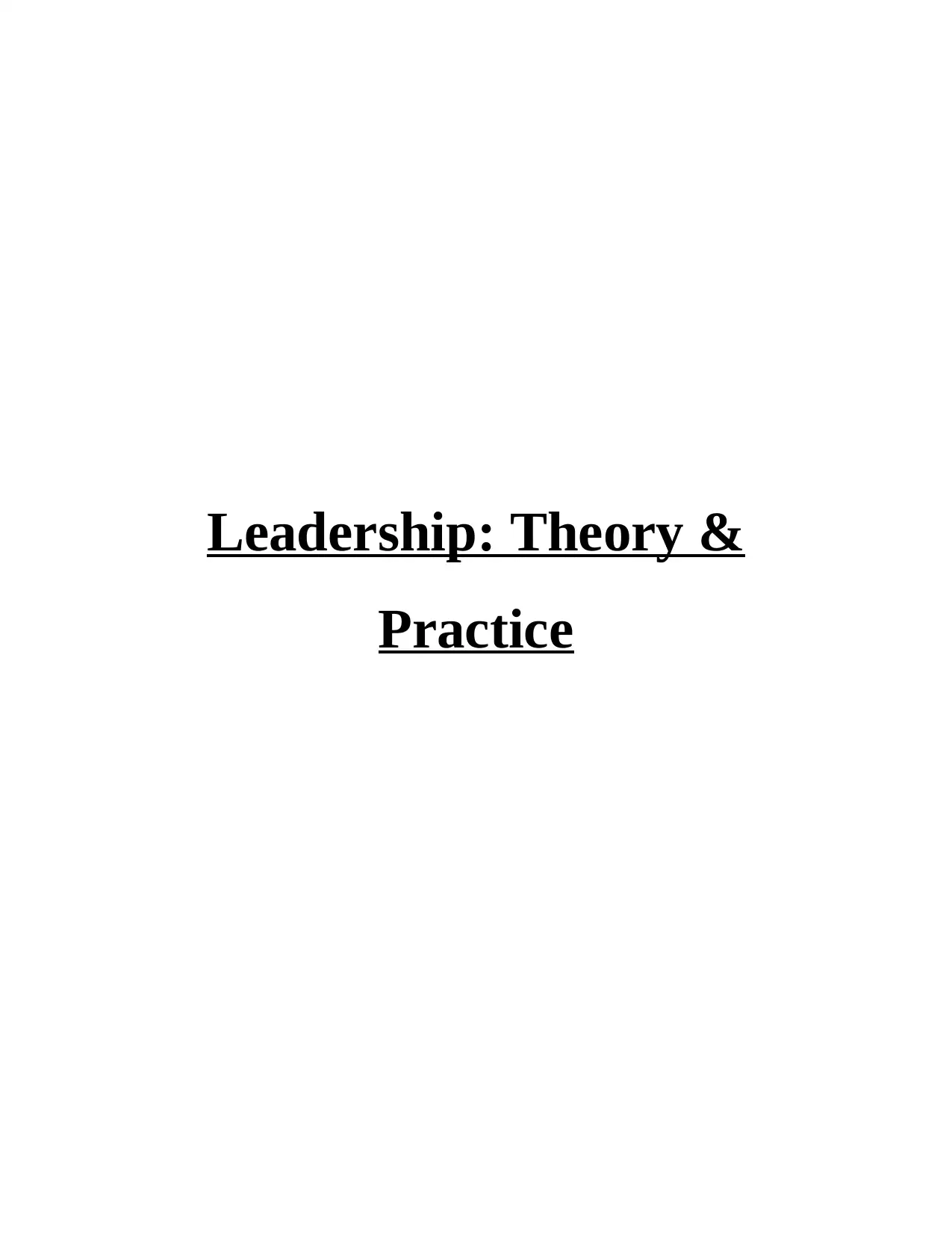
Leadership: Theory &
Practice
Practice
Paraphrase This Document
Need a fresh take? Get an instant paraphrase of this document with our AI Paraphraser
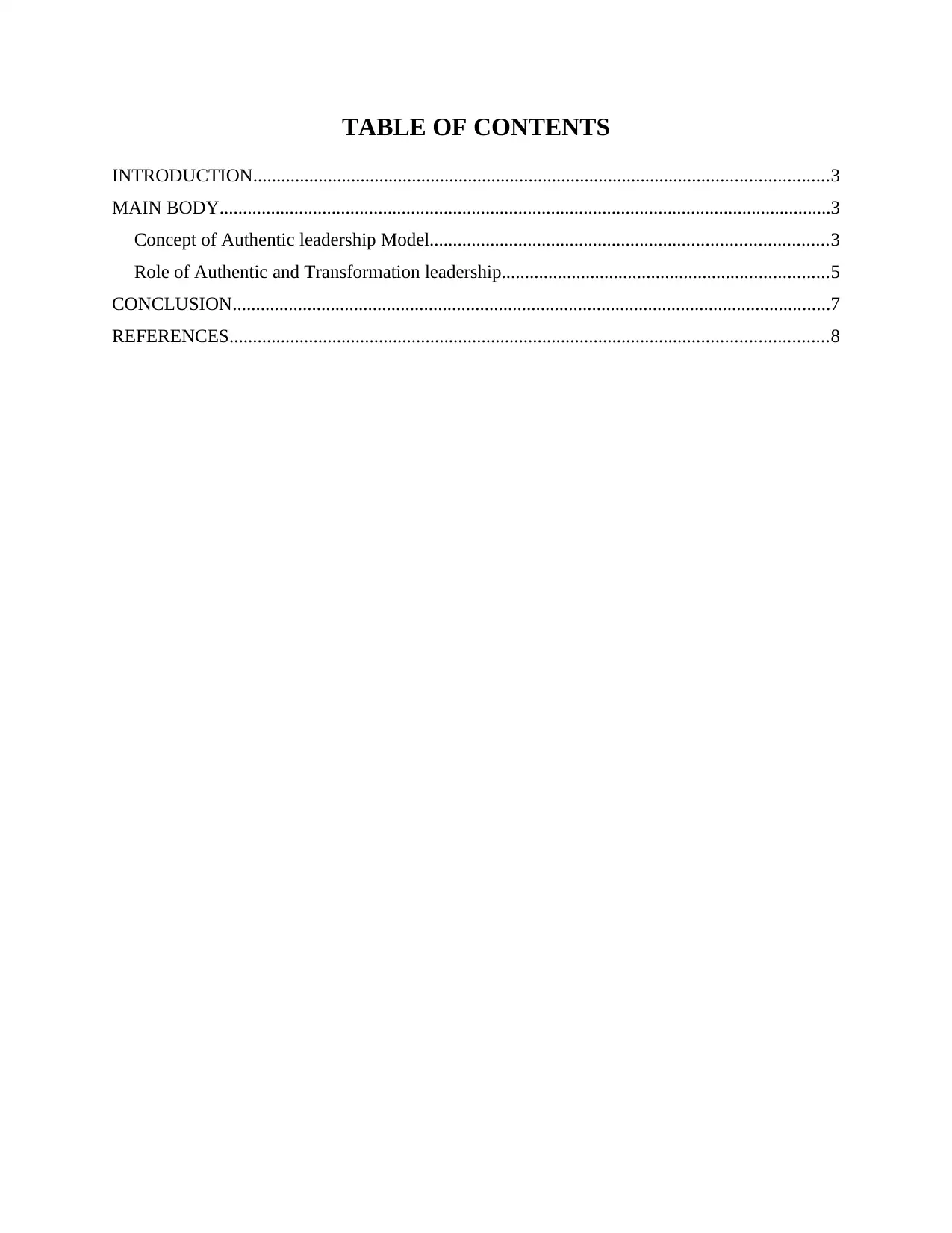
TABLE OF CONTENTS
INTRODUCTION...........................................................................................................................3
MAIN BODY...................................................................................................................................3
Concept of Authentic leadership Model.....................................................................................3
Role of Authentic and Transformation leadership......................................................................5
CONCLUSION................................................................................................................................7
REFERENCES................................................................................................................................8
INTRODUCTION...........................................................................................................................3
MAIN BODY...................................................................................................................................3
Concept of Authentic leadership Model.....................................................................................3
Role of Authentic and Transformation leadership......................................................................5
CONCLUSION................................................................................................................................7
REFERENCES................................................................................................................................8

INTRODUCTION
Leadership is basically an art of inspiring and motivating people within a group or team.
A leader is only person who employ the concept of leadership in its personal life. Leadership is
very important to lead, command, direct or control some member or employees in a team. In
short, a leader or leadership gives great contribution an organizational success.
MAIN BODY
Concept of Authentic leadership Model
Authentic leadership can be defined as the approach of leadership style in which leaders
are talented, self-aware, confident and trans[parent nature. A authentic leader has ability to
motivate loyalty and belief among the employee by keeping transparency in decision-making
process. Authentic leadership has goal to improve employees performance and make them feel
valuable by encouraging for their efforts. These activities support leader to build honest
relationship with followers or employees (Tepper and et.al., 2018). This leadership style plays
essential roles such as inspires group of employee at workplace. Even it supports employee to
learn new skills or tactic which improves their performance. Authentic leadership theory gives
guideline to a leader to improve their qualities which attracts group of employee to perform well.
This model contains five characteristics which helps leader to become effective leader within
company. Authentic leadership theory is basically dependent on four components which is
described below:
Self-Awareness: It is most important characteristic of authentic leadership model which
is interpreted that a leader should have self-awareness quality. It helps leader to understand
team's weakness and strength within workplace. Even it also supports leader to demonstrate own
portrait while performing as leader within company. Self-awareness characteristic helps' leader
to aware about team performance like they perform well r not at workplace (Dong and et.al.,
2017). To influence self-ware characteristic can practice by some tactic such as gathering of
feedbacks from the organization staff, customers and management department. Feedbacks
strategy not only helps to evaluate team performance but also assist to understand employees
behaviour towards their job. Otherwise, there is another tactic which also can help to improve
self-awareness for example self-reflection is good strategy which can help leader to understand
its behaviour within company. Even leader can get feedback about own performance from the
environment that automatically improves their self-awareness. Other the other hand, self-
Leadership is basically an art of inspiring and motivating people within a group or team.
A leader is only person who employ the concept of leadership in its personal life. Leadership is
very important to lead, command, direct or control some member or employees in a team. In
short, a leader or leadership gives great contribution an organizational success.
MAIN BODY
Concept of Authentic leadership Model
Authentic leadership can be defined as the approach of leadership style in which leaders
are talented, self-aware, confident and trans[parent nature. A authentic leader has ability to
motivate loyalty and belief among the employee by keeping transparency in decision-making
process. Authentic leadership has goal to improve employees performance and make them feel
valuable by encouraging for their efforts. These activities support leader to build honest
relationship with followers or employees (Tepper and et.al., 2018). This leadership style plays
essential roles such as inspires group of employee at workplace. Even it supports employee to
learn new skills or tactic which improves their performance. Authentic leadership theory gives
guideline to a leader to improve their qualities which attracts group of employee to perform well.
This model contains five characteristics which helps leader to become effective leader within
company. Authentic leadership theory is basically dependent on four components which is
described below:
Self-Awareness: It is most important characteristic of authentic leadership model which
is interpreted that a leader should have self-awareness quality. It helps leader to understand
team's weakness and strength within workplace. Even it also supports leader to demonstrate own
portrait while performing as leader within company. Self-awareness characteristic helps' leader
to aware about team performance like they perform well r not at workplace (Dong and et.al.,
2017). To influence self-ware characteristic can practice by some tactic such as gathering of
feedbacks from the organization staff, customers and management department. Feedbacks
strategy not only helps to evaluate team performance but also assist to understand employees
behaviour towards their job. Otherwise, there is another tactic which also can help to improve
self-awareness for example self-reflection is good strategy which can help leader to understand
its behaviour within company. Even leader can get feedback about own performance from the
environment that automatically improves their self-awareness. Other the other hand, self-
⊘ This is a preview!⊘
Do you want full access?
Subscribe today to unlock all pages.

Trusted by 1+ million students worldwide
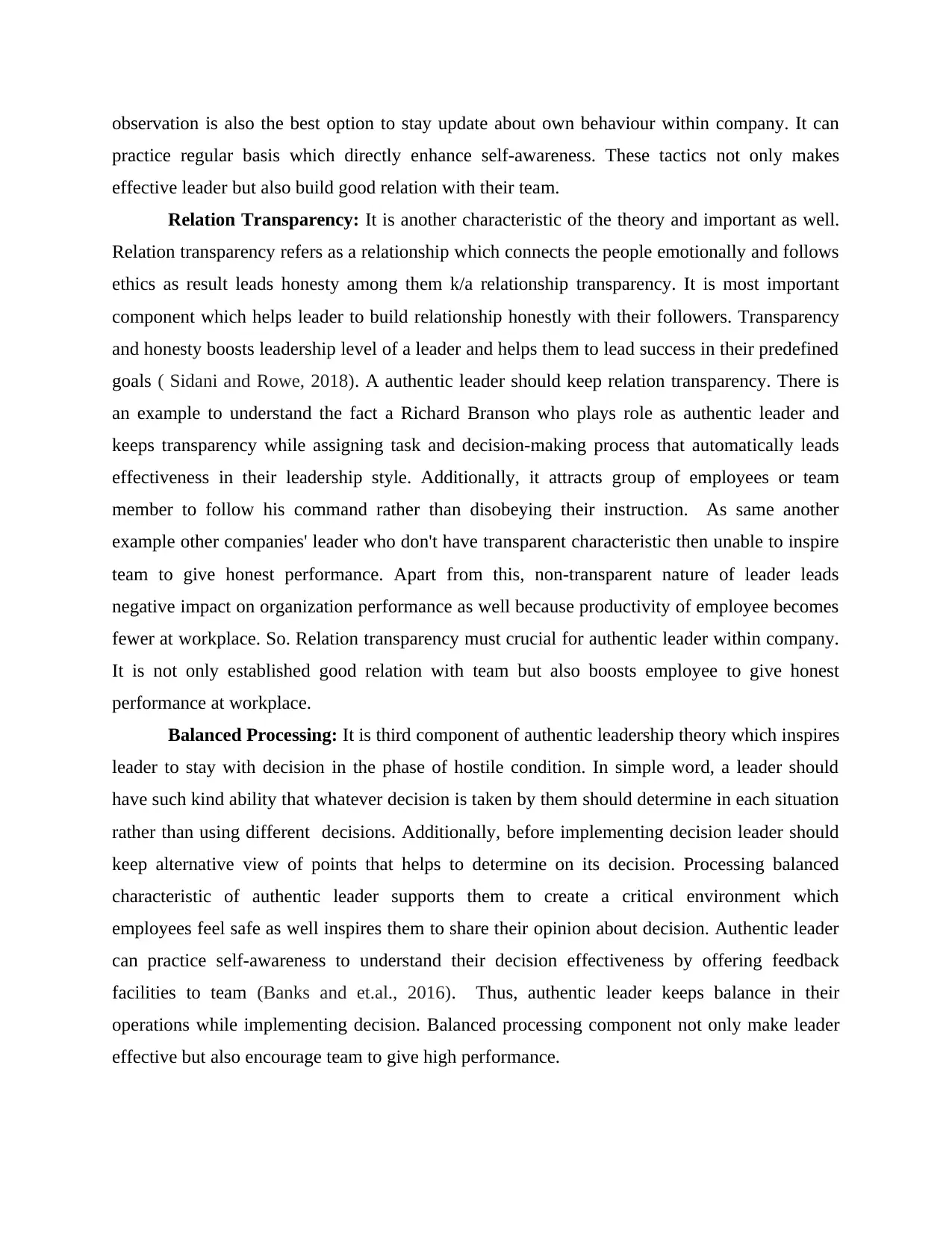
observation is also the best option to stay update about own behaviour within company. It can
practice regular basis which directly enhance self-awareness. These tactics not only makes
effective leader but also build good relation with their team.
Relation Transparency: It is another characteristic of the theory and important as well.
Relation transparency refers as a relationship which connects the people emotionally and follows
ethics as result leads honesty among them k/a relationship transparency. It is most important
component which helps leader to build relationship honestly with their followers. Transparency
and honesty boosts leadership level of a leader and helps them to lead success in their predefined
goals ( Sidani and Rowe, 2018). A authentic leader should keep relation transparency. There is
an example to understand the fact a Richard Branson who plays role as authentic leader and
keeps transparency while assigning task and decision-making process that automatically leads
effectiveness in their leadership style. Additionally, it attracts group of employees or team
member to follow his command rather than disobeying their instruction. As same another
example other companies' leader who don't have transparent characteristic then unable to inspire
team to give honest performance. Apart from this, non-transparent nature of leader leads
negative impact on organization performance as well because productivity of employee becomes
fewer at workplace. So. Relation transparency must crucial for authentic leader within company.
It is not only established good relation with team but also boosts employee to give honest
performance at workplace.
Balanced Processing: It is third component of authentic leadership theory which inspires
leader to stay with decision in the phase of hostile condition. In simple word, a leader should
have such kind ability that whatever decision is taken by them should determine in each situation
rather than using different decisions. Additionally, before implementing decision leader should
keep alternative view of points that helps to determine on its decision. Processing balanced
characteristic of authentic leader supports them to create a critical environment which
employees feel safe as well inspires them to share their opinion about decision. Authentic leader
can practice self-awareness to understand their decision effectiveness by offering feedback
facilities to team (Banks and et.al., 2016). Thus, authentic leader keeps balance in their
operations while implementing decision. Balanced processing component not only make leader
effective but also encourage team to give high performance.
practice regular basis which directly enhance self-awareness. These tactics not only makes
effective leader but also build good relation with their team.
Relation Transparency: It is another characteristic of the theory and important as well.
Relation transparency refers as a relationship which connects the people emotionally and follows
ethics as result leads honesty among them k/a relationship transparency. It is most important
component which helps leader to build relationship honestly with their followers. Transparency
and honesty boosts leadership level of a leader and helps them to lead success in their predefined
goals ( Sidani and Rowe, 2018). A authentic leader should keep relation transparency. There is
an example to understand the fact a Richard Branson who plays role as authentic leader and
keeps transparency while assigning task and decision-making process that automatically leads
effectiveness in their leadership style. Additionally, it attracts group of employees or team
member to follow his command rather than disobeying their instruction. As same another
example other companies' leader who don't have transparent characteristic then unable to inspire
team to give honest performance. Apart from this, non-transparent nature of leader leads
negative impact on organization performance as well because productivity of employee becomes
fewer at workplace. So. Relation transparency must crucial for authentic leader within company.
It is not only established good relation with team but also boosts employee to give honest
performance at workplace.
Balanced Processing: It is third component of authentic leadership theory which inspires
leader to stay with decision in the phase of hostile condition. In simple word, a leader should
have such kind ability that whatever decision is taken by them should determine in each situation
rather than using different decisions. Additionally, before implementing decision leader should
keep alternative view of points that helps to determine on its decision. Processing balanced
characteristic of authentic leader supports them to create a critical environment which
employees feel safe as well inspires them to share their opinion about decision. Authentic leader
can practice self-awareness to understand their decision effectiveness by offering feedback
facilities to team (Banks and et.al., 2016). Thus, authentic leader keeps balance in their
operations while implementing decision. Balanced processing component not only make leader
effective but also encourage team to give high performance.
Paraphrase This Document
Need a fresh take? Get an instant paraphrase of this document with our AI Paraphraser

Internalized Moral Perspective: It is also a crucial element of authentic leadership
which supports leader to do right things that automatically leads long term success within
company (Hambleton, 2017). Authentic leader should have strong ethical value and integrity
that leads effectiveness in their leadership. This characteristic leads effectiveness in decision-
making process of leader. Even leader becomes critical leader which improves their self-
awareness, transparent nature and make them determine in their decision in each phase of
opposition.
Application of the authentic leadership model
Authentic leadership model is based on the four component which helps leader to become
authentic leader. Self-awareness characteristic helps' leader to understand follower strength and
weakness of employee at workplace. Even leader can use feedback strategy in environment
which helps them to understand their behaviour at job place. Self-awareness nature inspires
group of people to follow leader honestly (Lyubovnikova and et.al., 2017). By this characteristic
leader can maintain well-being of follower within company. Relation transparent characteristic
can support leader to build good relation with followers. Other is balanced processing that can
improve decision-making process of leader. Determination on decision of leader can encourage
follower to follow their instruction. Authentic leader keep moral perspective which supports
them to do things accurately so that perceived positive outcomes. Thus, authentic leadership
model practices helps leader to encourage other or follower to follow their direction.
Role of Authentic and Transformation leadership
Leadership is always responsible to give orders to those employees who are comes under
its command. It is basically a way to lead people in an organization. Leadership has an approach
called authentic leadership (Aldulaimi, 2017). Authentic approach is helping to a leader to build
an effective relationship with their follower or employees. According to this authentic leadership,
a leader should build effective relationship with their team members to maintain healthy
environment within teamwork. On the other side, transformational leadership is a leadership
style. Under this style, a leader inspire, motivate and encourage their employees for creating and
innovating change within an organization. There is change is necessary to grow current business
environment of the any company. A leader can positively influence their all follower or members
through transformational leadership style (Hambleton, 2017). With the support of this style, a
leader is able to improve current performance level of their employees. The main role of
which supports leader to do right things that automatically leads long term success within
company (Hambleton, 2017). Authentic leader should have strong ethical value and integrity
that leads effectiveness in their leadership. This characteristic leads effectiveness in decision-
making process of leader. Even leader becomes critical leader which improves their self-
awareness, transparent nature and make them determine in their decision in each phase of
opposition.
Application of the authentic leadership model
Authentic leadership model is based on the four component which helps leader to become
authentic leader. Self-awareness characteristic helps' leader to understand follower strength and
weakness of employee at workplace. Even leader can use feedback strategy in environment
which helps them to understand their behaviour at job place. Self-awareness nature inspires
group of people to follow leader honestly (Lyubovnikova and et.al., 2017). By this characteristic
leader can maintain well-being of follower within company. Relation transparent characteristic
can support leader to build good relation with followers. Other is balanced processing that can
improve decision-making process of leader. Determination on decision of leader can encourage
follower to follow their instruction. Authentic leader keep moral perspective which supports
them to do things accurately so that perceived positive outcomes. Thus, authentic leadership
model practices helps leader to encourage other or follower to follow their direction.
Role of Authentic and Transformation leadership
Leadership is always responsible to give orders to those employees who are comes under
its command. It is basically a way to lead people in an organization. Leadership has an approach
called authentic leadership (Aldulaimi, 2017). Authentic approach is helping to a leader to build
an effective relationship with their follower or employees. According to this authentic leadership,
a leader should build effective relationship with their team members to maintain healthy
environment within teamwork. On the other side, transformational leadership is a leadership
style. Under this style, a leader inspire, motivate and encourage their employees for creating and
innovating change within an organization. There is change is necessary to grow current business
environment of the any company. A leader can positively influence their all follower or members
through transformational leadership style (Hambleton, 2017). With the support of this style, a
leader is able to improve current performance level of their employees. The main role of
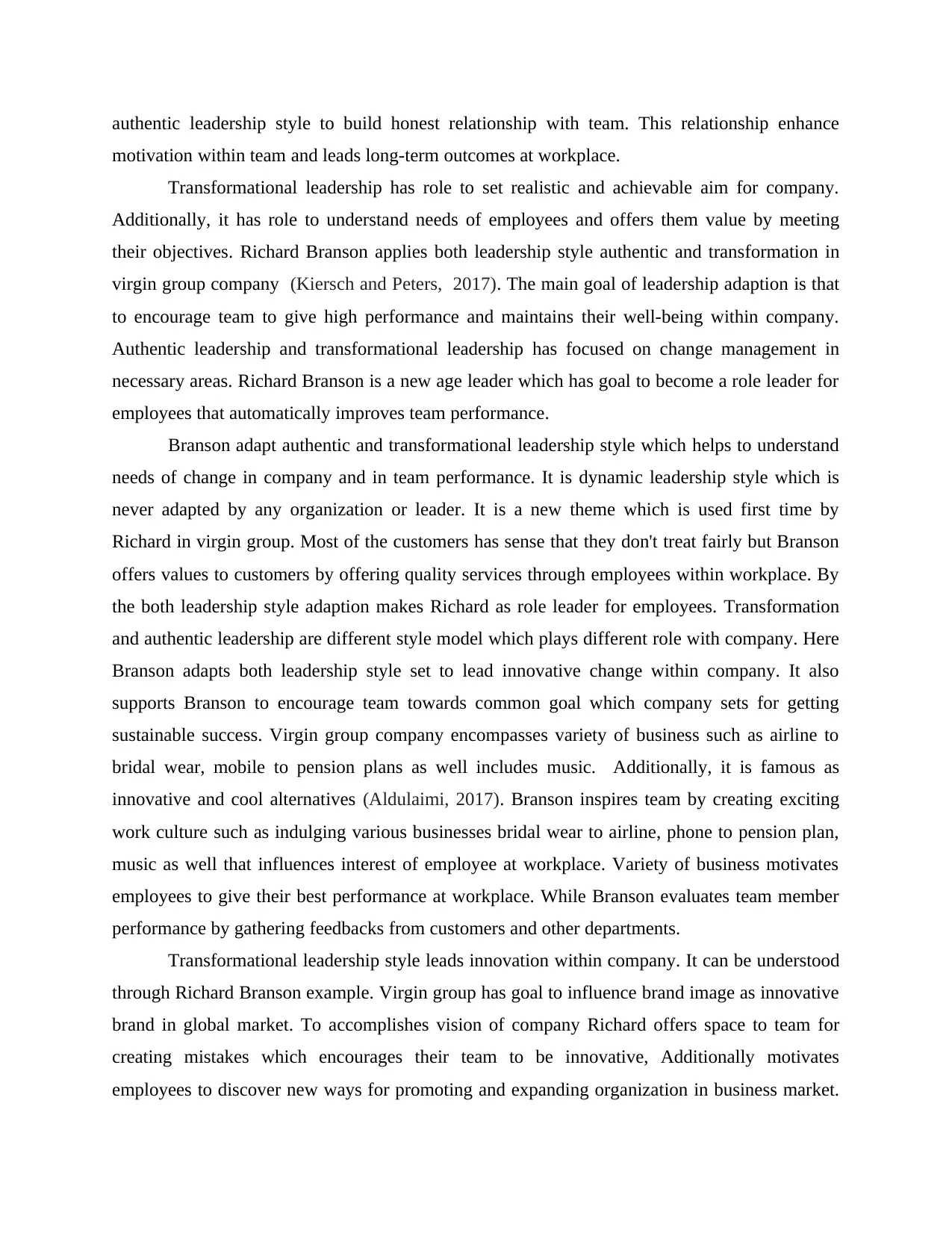
authentic leadership style to build honest relationship with team. This relationship enhance
motivation within team and leads long-term outcomes at workplace.
Transformational leadership has role to set realistic and achievable aim for company.
Additionally, it has role to understand needs of employees and offers them value by meeting
their objectives. Richard Branson applies both leadership style authentic and transformation in
virgin group company (Kiersch and Peters, 2017). The main goal of leadership adaption is that
to encourage team to give high performance and maintains their well-being within company.
Authentic leadership and transformational leadership has focused on change management in
necessary areas. Richard Branson is a new age leader which has goal to become a role leader for
employees that automatically improves team performance.
Branson adapt authentic and transformational leadership style which helps to understand
needs of change in company and in team performance. It is dynamic leadership style which is
never adapted by any organization or leader. It is a new theme which is used first time by
Richard in virgin group. Most of the customers has sense that they don't treat fairly but Branson
offers values to customers by offering quality services through employees within workplace. By
the both leadership style adaption makes Richard as role leader for employees. Transformation
and authentic leadership are different style model which plays different role with company. Here
Branson adapts both leadership style set to lead innovative change within company. It also
supports Branson to encourage team towards common goal which company sets for getting
sustainable success. Virgin group company encompasses variety of business such as airline to
bridal wear, mobile to pension plans as well includes music. Additionally, it is famous as
innovative and cool alternatives (Aldulaimi, 2017). Branson inspires team by creating exciting
work culture such as indulging various businesses bridal wear to airline, phone to pension plan,
music as well that influences interest of employee at workplace. Variety of business motivates
employees to give their best performance at workplace. While Branson evaluates team member
performance by gathering feedbacks from customers and other departments.
Transformational leadership style leads innovation within company. It can be understood
through Richard Branson example. Virgin group has goal to influence brand image as innovative
brand in global market. To accomplishes vision of company Richard offers space to team for
creating mistakes which encourages their team to be innovative, Additionally motivates
employees to discover new ways for promoting and expanding organization in business market.
motivation within team and leads long-term outcomes at workplace.
Transformational leadership has role to set realistic and achievable aim for company.
Additionally, it has role to understand needs of employees and offers them value by meeting
their objectives. Richard Branson applies both leadership style authentic and transformation in
virgin group company (Kiersch and Peters, 2017). The main goal of leadership adaption is that
to encourage team to give high performance and maintains their well-being within company.
Authentic leadership and transformational leadership has focused on change management in
necessary areas. Richard Branson is a new age leader which has goal to become a role leader for
employees that automatically improves team performance.
Branson adapt authentic and transformational leadership style which helps to understand
needs of change in company and in team performance. It is dynamic leadership style which is
never adapted by any organization or leader. It is a new theme which is used first time by
Richard in virgin group. Most of the customers has sense that they don't treat fairly but Branson
offers values to customers by offering quality services through employees within workplace. By
the both leadership style adaption makes Richard as role leader for employees. Transformation
and authentic leadership are different style model which plays different role with company. Here
Branson adapts both leadership style set to lead innovative change within company. It also
supports Branson to encourage team towards common goal which company sets for getting
sustainable success. Virgin group company encompasses variety of business such as airline to
bridal wear, mobile to pension plans as well includes music. Additionally, it is famous as
innovative and cool alternatives (Aldulaimi, 2017). Branson inspires team by creating exciting
work culture such as indulging various businesses bridal wear to airline, phone to pension plan,
music as well that influences interest of employee at workplace. Variety of business motivates
employees to give their best performance at workplace. While Branson evaluates team member
performance by gathering feedbacks from customers and other departments.
Transformational leadership style leads innovation within company. It can be understood
through Richard Branson example. Virgin group has goal to influence brand image as innovative
brand in global market. To accomplishes vision of company Richard offers space to team for
creating mistakes which encourages their team to be innovative, Additionally motivates
employees to discover new ways for promoting and expanding organization in business market.
⊘ This is a preview!⊘
Do you want full access?
Subscribe today to unlock all pages.

Trusted by 1+ million students worldwide
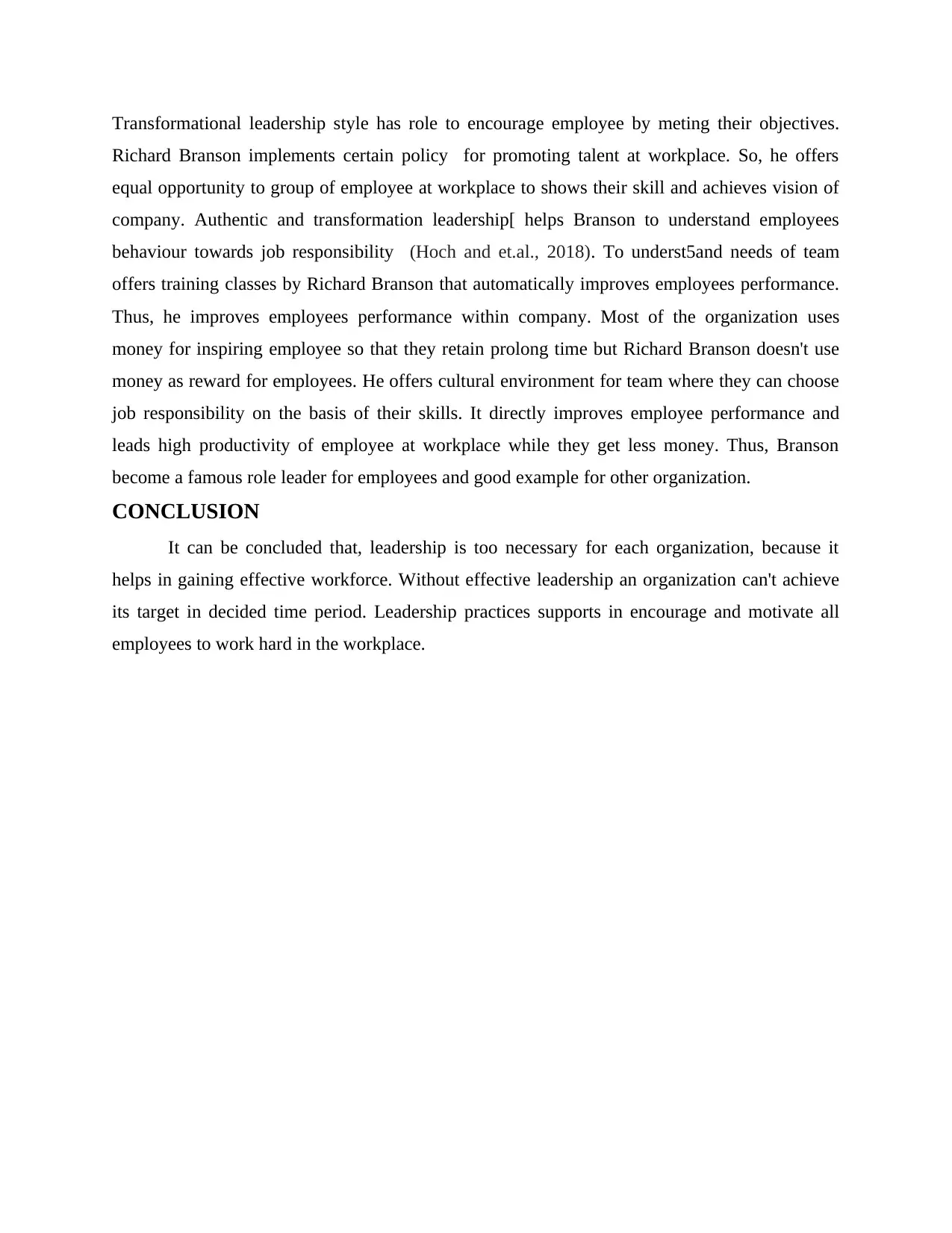
Transformational leadership style has role to encourage employee by meting their objectives.
Richard Branson implements certain policy for promoting talent at workplace. So, he offers
equal opportunity to group of employee at workplace to shows their skill and achieves vision of
company. Authentic and transformation leadership[ helps Branson to understand employees
behaviour towards job responsibility (Hoch and et.al., 2018). To underst5and needs of team
offers training classes by Richard Branson that automatically improves employees performance.
Thus, he improves employees performance within company. Most of the organization uses
money for inspiring employee so that they retain prolong time but Richard Branson doesn't use
money as reward for employees. He offers cultural environment for team where they can choose
job responsibility on the basis of their skills. It directly improves employee performance and
leads high productivity of employee at workplace while they get less money. Thus, Branson
become a famous role leader for employees and good example for other organization.
CONCLUSION
It can be concluded that, leadership is too necessary for each organization, because it
helps in gaining effective workforce. Without effective leadership an organization can't achieve
its target in decided time period. Leadership practices supports in encourage and motivate all
employees to work hard in the workplace.
Richard Branson implements certain policy for promoting talent at workplace. So, he offers
equal opportunity to group of employee at workplace to shows their skill and achieves vision of
company. Authentic and transformation leadership[ helps Branson to understand employees
behaviour towards job responsibility (Hoch and et.al., 2018). To underst5and needs of team
offers training classes by Richard Branson that automatically improves employees performance.
Thus, he improves employees performance within company. Most of the organization uses
money for inspiring employee so that they retain prolong time but Richard Branson doesn't use
money as reward for employees. He offers cultural environment for team where they can choose
job responsibility on the basis of their skills. It directly improves employee performance and
leads high productivity of employee at workplace while they get less money. Thus, Branson
become a famous role leader for employees and good example for other organization.
CONCLUSION
It can be concluded that, leadership is too necessary for each organization, because it
helps in gaining effective workforce. Without effective leadership an organization can't achieve
its target in decided time period. Leadership practices supports in encourage and motivate all
employees to work hard in the workplace.
Paraphrase This Document
Need a fresh take? Get an instant paraphrase of this document with our AI Paraphraser
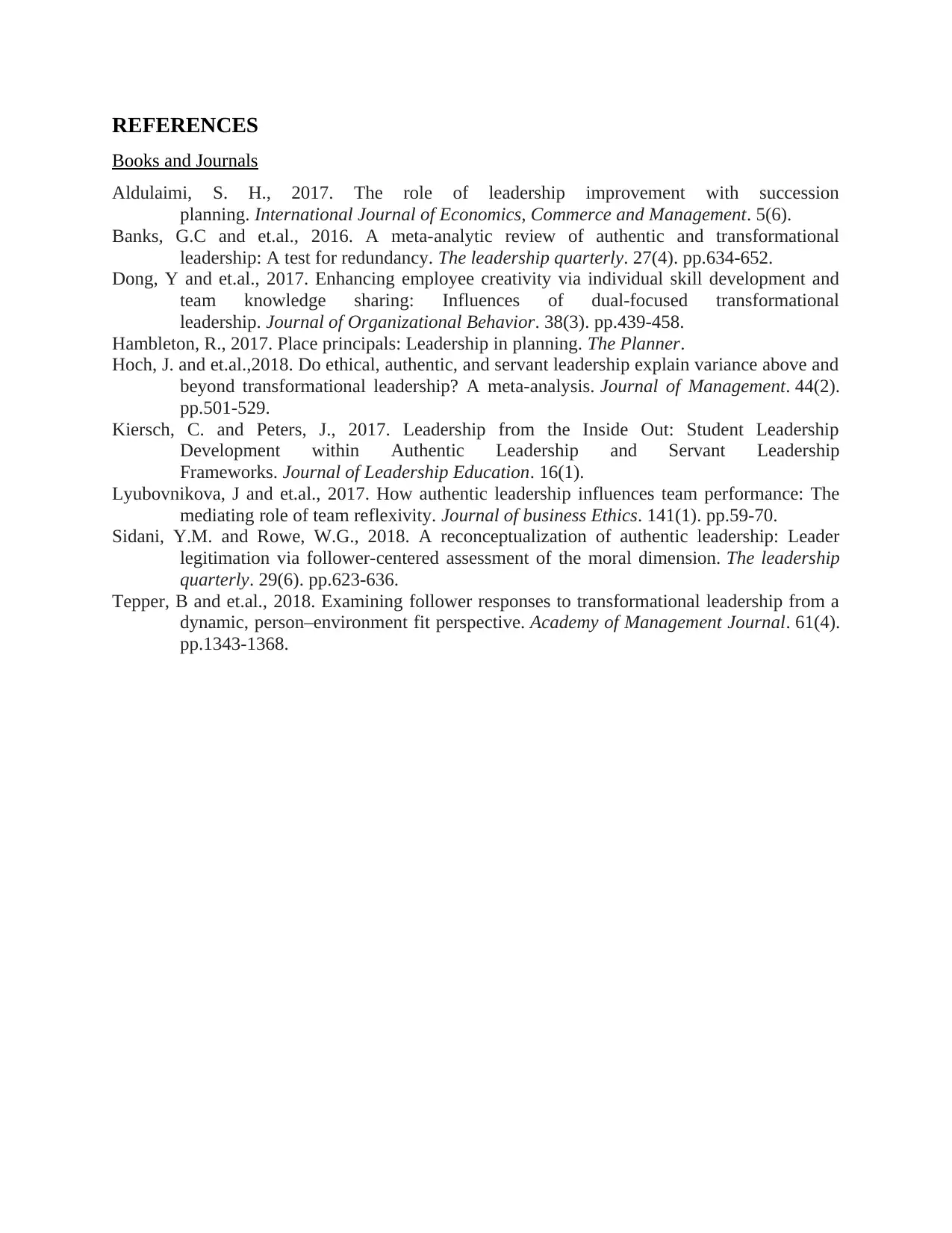
REFERENCES
Books and Journals
Aldulaimi, S. H., 2017. The role of leadership improvement with succession
planning. International Journal of Economics, Commerce and Management. 5(6).
Banks, G.C and et.al., 2016. A meta-analytic review of authentic and transformational
leadership: A test for redundancy. The leadership quarterly. 27(4). pp.634-652.
Dong, Y and et.al., 2017. Enhancing employee creativity via individual skill development and
team knowledge sharing: Influences of dual‐focused transformational
leadership. Journal of Organizational Behavior. 38(3). pp.439-458.
Hambleton, R., 2017. Place principals: Leadership in planning. The Planner.
Hoch, J. and et.al.,2018. Do ethical, authentic, and servant leadership explain variance above and
beyond transformational leadership? A meta-analysis. Journal of Management. 44(2).
pp.501-529.
Kiersch, C. and Peters, J., 2017. Leadership from the Inside Out: Student Leadership
Development within Authentic Leadership and Servant Leadership
Frameworks. Journal of Leadership Education. 16(1).
Lyubovnikova, J and et.al., 2017. How authentic leadership influences team performance: The
mediating role of team reflexivity. Journal of business Ethics. 141(1). pp.59-70.
Sidani, Y.M. and Rowe, W.G., 2018. A reconceptualization of authentic leadership: Leader
legitimation via follower-centered assessment of the moral dimension. The leadership
quarterly. 29(6). pp.623-636.
Tepper, B and et.al., 2018. Examining follower responses to transformational leadership from a
dynamic, person–environment fit perspective. Academy of Management Journal. 61(4).
pp.1343-1368.
Books and Journals
Aldulaimi, S. H., 2017. The role of leadership improvement with succession
planning. International Journal of Economics, Commerce and Management. 5(6).
Banks, G.C and et.al., 2016. A meta-analytic review of authentic and transformational
leadership: A test for redundancy. The leadership quarterly. 27(4). pp.634-652.
Dong, Y and et.al., 2017. Enhancing employee creativity via individual skill development and
team knowledge sharing: Influences of dual‐focused transformational
leadership. Journal of Organizational Behavior. 38(3). pp.439-458.
Hambleton, R., 2017. Place principals: Leadership in planning. The Planner.
Hoch, J. and et.al.,2018. Do ethical, authentic, and servant leadership explain variance above and
beyond transformational leadership? A meta-analysis. Journal of Management. 44(2).
pp.501-529.
Kiersch, C. and Peters, J., 2017. Leadership from the Inside Out: Student Leadership
Development within Authentic Leadership and Servant Leadership
Frameworks. Journal of Leadership Education. 16(1).
Lyubovnikova, J and et.al., 2017. How authentic leadership influences team performance: The
mediating role of team reflexivity. Journal of business Ethics. 141(1). pp.59-70.
Sidani, Y.M. and Rowe, W.G., 2018. A reconceptualization of authentic leadership: Leader
legitimation via follower-centered assessment of the moral dimension. The leadership
quarterly. 29(6). pp.623-636.
Tepper, B and et.al., 2018. Examining follower responses to transformational leadership from a
dynamic, person–environment fit perspective. Academy of Management Journal. 61(4).
pp.1343-1368.
1 out of 8
Related Documents
Your All-in-One AI-Powered Toolkit for Academic Success.
+13062052269
info@desklib.com
Available 24*7 on WhatsApp / Email
![[object Object]](/_next/static/media/star-bottom.7253800d.svg)
Unlock your academic potential
Copyright © 2020–2025 A2Z Services. All Rights Reserved. Developed and managed by ZUCOL.




